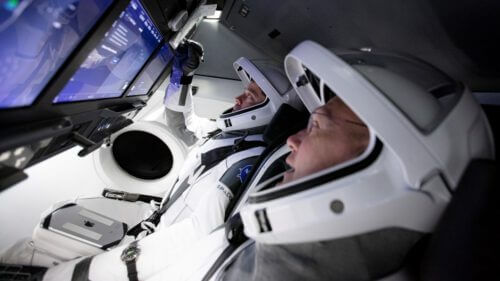SpaceX and NASA received the approval of the control personnel to launch the Crew Dragon spacecraft on a test flight to the space station. The flight will be manned by two NASA astronauts who are also test pilots in their training. They will join the crew of the space station for an undetermined period of time, at the end of which they will drop near the coast of Florida

SpaceX and NASA received the approval of the control personnel to launch the Crew Dragon spacecraft on a test flight to the space station known as Demo-2. It will be the first manned launch from US soil since the termination of the space shuttle program in 2011. The launch is scheduled for Wednesday, May 27, 2020 at 16:33 PM (ie 23:33 PM Israel time). From Launch Complex 39A in Cape Canaveral, Florida.
The spacecraft will be manned by Robert Banken and Douglas Hurley, two NASA astronauts who are also test pilots in training. In the subsequent commercial flights, astronauts who are not necessarily affiliated with NASA will also fly. As SpaceX's final flight test for commercial approval, this mission will verify the functioning of all the infrastructure built by the company, including the launch pad, spacecraft and operational capabilities. This will also be the first time that NASA astronauts will test the spacecraft's systems in orbit.
Banken and Hurley were among the first astronauts to begin working and training on SpaceX's next-generation human space vehicle and were chosen because they are test pilots by profession and each of them has a number of space shuttle missions behind them.
Banken will be the commander of the joint operations in the mission and will be responsible for activities such as the rendezvous and docking at the space station and the activities that will take place when the spacecraft docks at the space station. He was selected as a NASA astronaut in 2000 and completed two space shuttle flights: STS-123 in March 2008 and STS-130 in February 2010. He also performed three spacewalks during each mission. Has a PhD in physics and mechanical engineering from Caltech. Before joining NASA, he worked as a flight test engineer in the US Air Force.
Harley will be the commander of the spacecraft and will be responsible for the launch, landing and recovery from the ocean after landing. He was also selected as an astronaut in 2000 and participated in two shuttle flights, STS - 127 in July 2009 and STS - 135, the last space shuttle mission in July 2011. He graduated from the Maryland Test Pilot School. Before joining NASA, he was a fighter pilot and test pilot in the US Marine Corps.
The Crew Dragon spacecraft will be launched on a Falcon 9 rocket. After the launch, the launcher will accelerate it to a speed of about 27,000 km/h on a path that will meet it with the space station. When the spacecraft is in orbit, the astronauts and the SpaceX ground crew will check the functioning of the spacecraft's systems. Only 24 hours later they will arrive to rendezvous and dock with the space station. The spacecraft can carry out all these processes autonomously, but the astronauts on board and aboard the space station will diligently monitor the rendezvous and docking and will be able to take control of the spacecraft if necessary.
After the successful docking, Banken and Hurley will become the 63rd crew members. They will perform tests of the Crew Dragon spacecraft and also participate in other missions of the space station crew.
Although the Crew Dragon spacecraft built for Operation DEMO-2 can remain in space for 110 days, the specific mission duration will be determined when they are on station, depending on SpaceX's readiness for the next Crew Dragon launch for its first commercial mission. The operational Crew Dragon spacecraft will be able to remain in orbit for at least 210 days as required by NASA.
At the end of the mission, Crew Dragon will open and the two astronauts will leave the space station and re-enter the Earth's atmosphere. They are supposed to crash near Florida's Atlantic coast. Crew members will be picked up at sea by SpaceX's Go Navigator rescue ship and returned to Cape Canaveral.
The Demo-2 mission will be the final major step before NASA's Commercial Crew Program approves Crew Dragon for long-duration operational missions to the space station. The certification of SpaceX and permanent operation of Crew Dragon by it will allow NASA to continue the scientific and technological research taking place at the space station, and will lay the foundations for manned flights to the Moon and Mars, which will begin with the launch of two astronauts, this time a man and a woman, to the Moon in 2024.
More of the topic in Hayadan:
SpaceX and NASA announce: first manned launch in a decade from the USA - on May 27
The Crew Dragon spacecraft has successfully landed in the Atlantic Ocean * The next demonstration mission will already be manned

4 תגובות
night
This Wednesday, at 11:33 Israel time, according to the Israel Space Agency... so when is the flight, in the morning or at night?
Avichai
what?
Why don't the punch-ball believers back up and fund one fool they trust to fly on this private flight?